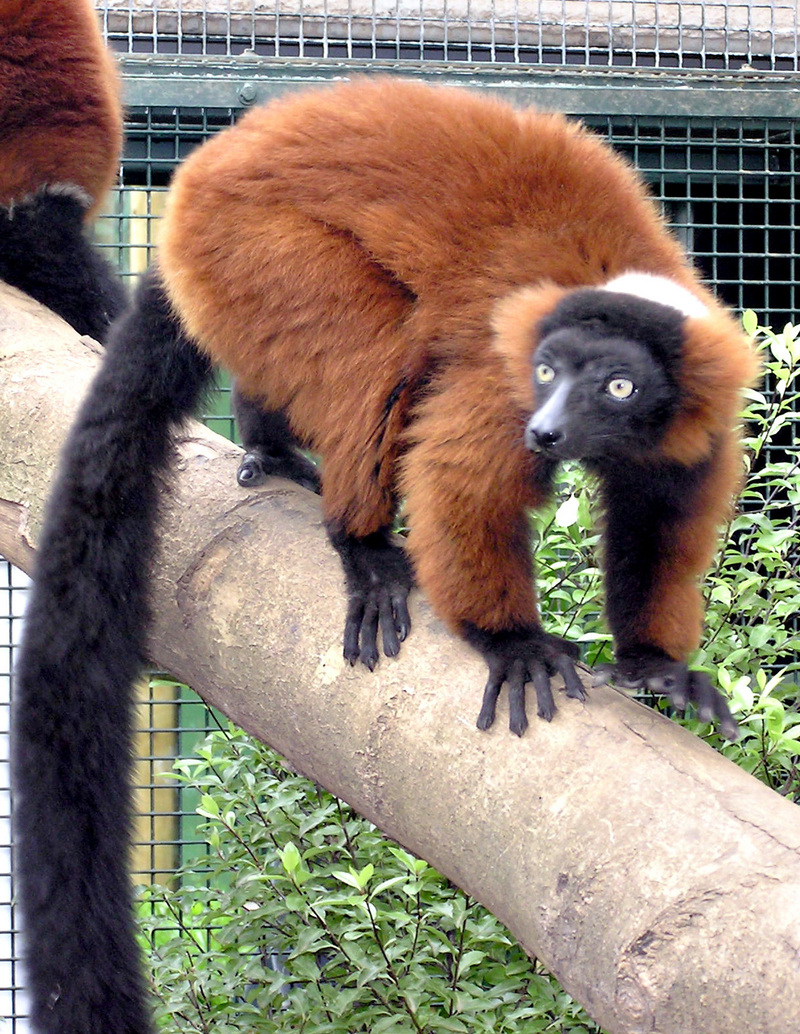|
| 질의: Small white | 결과: 718번째/2237 | |
Red Ruffed Lemur (Varecia rubra) - Wiki
| 제목: | Red Ruffed Lemur (Varecia rubra) - Wiki
| |

| 해상도: 1207x1560
파일크기: 695486 Bytes
촬영일: 0000:00:00 00:00:00
사진기: C750UZ (OLYMPUS CORPORATION)
F number: f/3.2
Exposure: 10/1000 sec
Focal Length: 158/10
등록시간: 2007:10:19 16:36:59
|
Red Ruffed Lemur
From Wikipedia, the free encyclopedia
[Photo] Red Ruffed Lemur Varecia rubra at Bristol Zoo, Bristol, England . Taken by Adrian Pingstone (http://commons.wikimedia.org/wiki/User:Arpingstone) in October 2006 and placed in the public domain.
The Red Ruffed Lemur (Varecia rubra) is one of two species in the genus Varecia, the ruffed lemurs; the other is the Black-and-white Ruffed Lemur (Varecia variegata). Like all lemurs, it is native to Madagascar and occurs only in the rainforests of Masoala, in the northeast of the island.
Description
The Red Ruffed Lemur weighs 3.5-4 kg. It is about 53 cm long, with a 60 cm tail. Females are slightly larger than males.
As its name would suggest, it has a rust-coloured ruff and body. Its head, stomach, tail, feet, and the insides of its legs are black. It has a white patch on the back of its neck, and may also have white markings on its feet or mouth.
Behaviour
This prosimian typically lives in small, matriarchal groups of 2-16 individuals, but group sizes of up to 32 have been recorded. Its diet consists primarily of fruit, nectar, and pollen. Leaves and seeds may be eaten when fruit becomes scarce.
The Red Ruffed Lemur lives 15-20 years in the wild. In captivity, 25 years is not uncommon, and one lived to be about 33 years old. It is a diurnal animal, and most active in the morning and evening.
The Duke Lemur Center has recorded about twelve different calls. The Red Ruffed Lemur and Black-and-White Ruffed Lemur understand each other's calls, despite living in different parts of Madagascar. Scent marking is also an important means of communication.
Breeding
Unlike all other diurnal primates, females build nests 10-20 m off the forest floor, made with twigs, leaves, vines, and fur. Breeding takes place from May to July. Ruffed lemurs are also the only primates with litters of young, and, after a gestation period of 102 days, the female may give birth to up to six, although two or three is more typical. Newborns have fur and can see, but as they are immobile, the female leaves them in the nest until they are seven weeks old. Weaning occurs at four months. It is estimated that 65% of young do not reach three months of age, and often die by falling from the trees.
Conservation
The IUCN Red List considers the Red Ruffed Lemur to be critically endangered, listing habitat loss, hunting, and the pet trade as primary threats. The creation of the Masoala National Park in 1997 has helped protect this species, but many Red Ruffed Lemurs do not live within the park's boundaries, and are still at high risk.
http://en.wikipedia.org/wiki/Red_Ruffed_Lemur
| The text in this page is based on the copyrighted Wikipedia article shown in above URL. It is used under the GNU Free Documentation License. You may redistribute it, verbatim or modified, providing that you comply with the terms of the GFDL. |
|
댓글 |
|---|
| | 손님 |
|
Red Ruffed lemur (Varecia rubra)
The ruffed lemur is the largest of the lemur family, and is divided into two very distinctive species; the black-and-white ruffed lemur (Varecia variegata) and the red ruffed lemur (Varecia rubra). The two species are similar in shape, size, life history and behaviour but are different in colouration and habitat. The black-and-white ruffed lemur has, as its name suggests, a black and white pelage with white tufted ears, a long tail and bright, beady yellow eyes. The red ruffed lemur is a striking chestnut red colour, with a much more dense and luxuriant pelage, and a black coloured face, limbs and tail. Originally considered to be conspecific, recent genetic studies strongly suggested that these two forms merit distinction as separate species. |
| | 손님 |
|
| what do you think about them having to face habitat loss |
^o^
동물그림창고 똑똑전화 누리집
^o^
|
|
|

